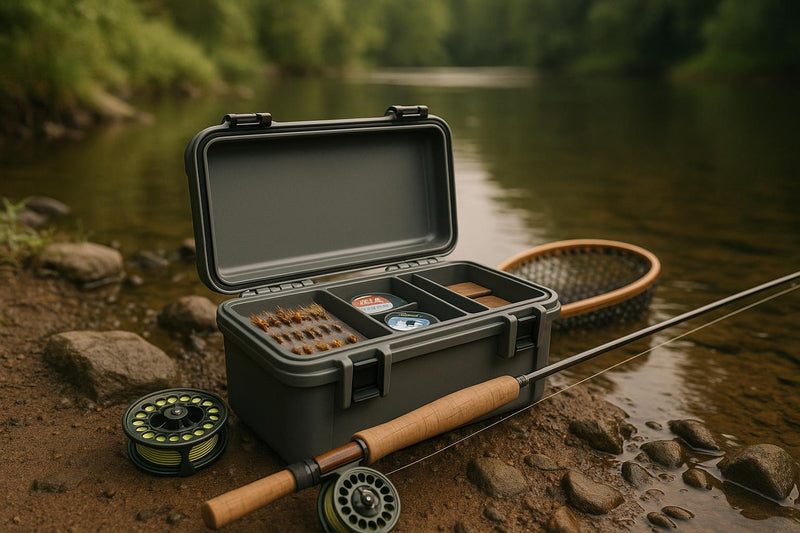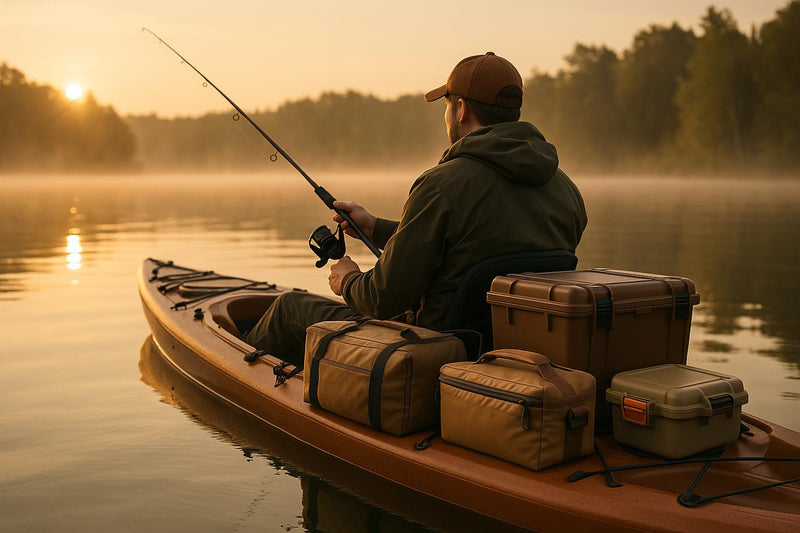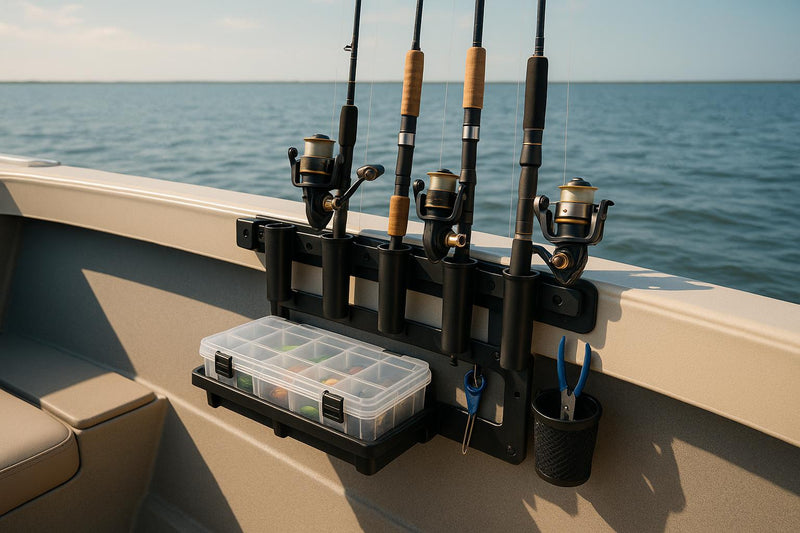Fishing for hours can be tough on your body, especially when leaning against hard boat rails. Rail padding can help by providing support and reducing strain during long trips. The best materials for rail padding balance comfort, durability, and ease of maintenance. Here's a quick rundown:
- Closed-Cell Foam: Water-resistant, bacteria-resistant, and provides steady support.
- Flexible Vinyl: Durable, easy to install, and handles UV rays and marine chemicals well.
- EVA Foam: Great cushioning, shock absorption, and easy to customize for various rail shapes.
Each material has its strengths. For example, EVA foam excels in comfort, flexible vinyl is long-lasting, and closed-cell foam is low-maintenance. Pairing rail padding with padded fishing shorts can further improve comfort by addressing lower-body pressure points. Together, they create a system that makes long fishing sessions more enjoyable.
Key Features of Quality Rail Padding Materials
To make your time on the water more comfortable, rail padding needs to combine toughness, ergonomic design, and low-maintenance care. Let’s take a closer look at what makes quality rail padding stand out.
Durability and Water Resistance
Fishing environments are tough on gear, so your rail padding has to handle constant exposure to water and wear without breaking down. Water resistance is key to preventing material deterioration.
Closed-cell foam is a standout choice here. It doesn’t absorb water, so it won’t get soggy, smelly, or harbor bacteria. Similarly, PVC fabrics are another excellent option. Their smooth, water-resistant surface makes cleaning up after a messy day of fishing much easier.
Think of it this way: just as you’d pick water-resistant gear for yourself, your rail padding deserves the same consideration to keep performing trip after trip.
Ergonomic and Flexible Design
Once durability is covered, the next priority is comfort. But comfort isn’t just about softness - it’s about how well the padding supports your body during long hours on the water.
"That ergonomic design is what's really important here, delivering plenty of support on those all-day adventures on the water."
– Algona Marine Iowa
The best rail padding strikes a balance between cushioning and firmness. Too soft, and you’ll sink in too much; too firm, and it won’t provide relief. High-quality padding molds to your body’s natural shape while holding its structure over time.
Flexibility is another must-have, especially for padding that needs to fit curved rails or different boat layouts. Materials that bend and adapt without cracking ensure a snug fit and continued protection across various designs.
For all-day comfort, consider pairing ergonomic rail padding with padded fishing shorts that include removable thigh pads for extra support.
Easy Maintenance
After a successful day on the water, the last thing you want is a cleaning headache. Rail padding that’s easy to maintain saves time and keeps your gear in great shape for future trips.
Vinyl-coated polyester fabrics are a strong choice. They’re waterproof, abrasion-resistant, and designed to resist mold, mildew, and stains. Whether it’s fish blood or bait spills, these materials can handle it without leaving permanent marks.
Closed-cell foam is another low-maintenance option. A quick scrub with warm soapy water is usually all it takes to get it clean. This means less time scrubbing and more time enjoying your catch.
Some vinyl-coated polyester mesh materials even come with antimicrobial treatments to reduce bacteria, mold, and mildew growth. This not only cuts down on odors but also extends the time between deep cleanings.
With stain-resistant properties, quality rail padding ensures that even the toughest fishing messes won’t leave lasting marks, keeping your boat looking clean and well-kept.
These essential features lay the groundwork for evaluating specific material options in the next section.
Best Rail Padding Materials for Angler Comfort
When you're out on the water for hours, comfort matters. Choosing the right rail padding can make those long fishing sessions more enjoyable. Below are three materials that stand out for their balance of durability, comfort, and practicality. Understanding their features can help you pick the best fit for your needs.
Closed-Cell Foam
Closed-cell foam is a go-to option for many anglers. Its water-resistant structure keeps it from soaking up moisture, making it a reliable choice in wet conditions. This material provides consistent support and holds up well over time, even with frequent use. Some versions are treated to resist bacteria and mold, which helps keep your gear cleaner and fresher for longer.
Flexible Vinyl
Flexible vinyl is a versatile choice, offering a mix of durability and ease of installation. It’s pliable enough to wrap around curved rails, making it a favorite for DIY setups. High-quality vinyl is built to withstand challenges like UV rays, marine chemicals, and fading. Plus, its textured surface improves grip, adding an extra layer of safety - especially when things get slippery.
EVA Foam
EVA foam (Ethylene Vinyl Acetate) is ideal for anglers who prioritize comfort. Known for its excellent cushioning, it helps reduce pressure points and absorbs shocks from boat movements or waves. This foam is easy to customize, as it can be cut to fit various rail shapes. Its non-slip surface enhances safety, while its quick recovery after compression ensures long-lasting performance. Pairing EVA foam with premium gear, such as Fishing shorts or Mens Fishing Shorts, can make your time on the water even more enjoyable.
Rail Padding Material Comparison
Choosing the best rail padding material depends on your specific fishing needs. Each material comes with its own set of strengths, so understanding these differences can help you make the right choice for your setup.
Comfort levels vary significantly between options. EVA foam stands out for its cushioning, which minimizes pressure points during long fishing trips. Its shock-absorbing qualities make it ideal for rough waters. Closed-cell foam provides steady support, while flexible vinyl offers decent cushioning but is better suited for other strengths.
Durability is a key factor where flexible vinyl excels. It resists UV rays, marine chemicals, and general wear, making it a reliable long-term option. Closed-cell foam also performs well, maintaining its structure and resisting moisture, though it may wear out faster than vinyl. EVA foam is durable but may require more care to maintain its performance over time.
Ease of installation depends on your boat's design and your DIY skills. Flexible vinyl is highly versatile, easily wrapping around curved rails and uneven shapes. EVA foam is also easy to work with and can be cut to custom sizes using basic tools. Closed-cell foam, while secure once installed, often demands more precision during fitting.
Maintenance requirements vary by material. Closed-cell foam is low-maintenance, thanks to its water-resistant and bacteria-resistant properties. Flexible vinyl requires occasional cleaning but resists staining and fading. EVA foam, while easy to clean, may need more frequent attention to preserve its texture and comfort. Here's a quick comparison:
| Material | Comfort Level | Durability | Installation | Maintenance | Ideal For |
|---|---|---|---|---|---|
| Closed-Cell Foam | Good | Very Good | Moderate | Low | Consistent support, wet environments |
| Flexible Vinyl | Fair | Excellent | Easy | Low | Curved rails, long-term durability |
| EVA Foam | Excellent | Good | Easy | Moderate | Maximum comfort, custom fitting |
Cost is another consideration. Closed-cell foam offers solid performance at a reasonable price. EVA foam tends to fall in the mid-range, with premium options costing more for added comfort. Flexible vinyl prices vary widely depending on thickness and UV protection features.
Grip in wet conditions is also essential. EVA foam provides excellent traction with its textured surface, reducing the risk of slipping on the boat. Flexible vinyl offers good grip through its finish, while closed-cell foam provides basic traction, which can be enhanced with surface treatments if needed.
For the best fishing experience, consider pairing quality rail padding with padded fishing shorts. This combination ensures both your boat and your gear contribute to your comfort on the water.
Weather resistance is another important factor. Closed-cell foam thrives in consistently wet conditions, maintaining its performance despite moisture exposure. Flexible vinyl handles extreme temperatures well, staying flexible in the cold and firm in the heat. EVA foam performs reliably across various conditions but benefits from proper drying to maintain its cushioning over time.
sbb-itb-cb0a783
Improving Angler Comfort with Premium Fishing Gear
Pairing rail padding with specialized fishing gear takes angler comfort to the next level. While rail padding does a great job of protecting your back and sides during those long hours of fishing, true comfort means addressing all the pressure points your body might encounter. For instance, while rail padding supports your back and sides, your thighs and groin often bear the brunt during intense battles with big fish.
That’s where Mens Fishing Shorts from Reel Comfort come in. These shorts are designed with integrated thigh and groin cushioning, filling the gap that rail padding leaves behind. With low-profile, removable thigh pads priced at $59.99, they provide targeted support for those areas that rail padding can’t cover.
"Finally, I can fight big fish without wrecking my thigh or groin." – Reel Comfort Customer
The shorts also feature built-in seat cushioning, which makes a big difference when you're sitting for extended periods - whether on a boat bench, kayak seat, cooler, or even the edge of a dock. This cushioning works hand-in-hand with rail padding, ensuring you're comfortable whether you're leaning against the rails or taking a well-deserved seated break.
Made from a quick-dry, breathable fabric blend, these shorts are designed for all-day wear. The stretch waistband and athletic cut allow for unrestricted movement, even in wet conditions. Thanks to quick-dry fabric technology, you stay comfortable and mobile no matter how much water gets involved. This design pairs perfectly with flexible rail padding materials like EVA foam, creating a seamless system that keeps you moving freely on deck.
The shorts also come with integrated pockets, keeping essential tools like tackle and pliers within easy reach. Their low-profile design ensures they don’t add unnecessary bulk, so you can move around padded rails without any hassle.
When combined with high-quality rail padding, these shorts form a dual-layer system that fights fatigue and keeps you comfortable. Built to last, they’re made with durable materials and reinforced stitching to withstand saltwater, UV rays, and countless wash cycles - perfect for anglers who spend season after season on the water.
This combination of apparel and rail padding offers a complete comfort solution, transforming every moment on the water into a more enjoyable experience. Understanding the differences between padded fishing shorts and regular alternatives can help anglers make smarter choices when building their ultimate comfort system. Together, quality rail padding and purpose-built fishing shorts tackle pressure points from every angle, enhancing your fishing experience in ways you’ll truly appreciate.
Conclusion: Choosing the Right Rail Padding for Angler Comfort
Selecting the right rail padding can make a world of difference for your comfort out on the water. EVA foam stands out for its excellent cushioning, durability, and resistance to water, while closed-cell foam offers a more budget-friendly option with reliable support. Flexible vinyl, on the other hand, is a low-maintenance choice that’s built to last.
The ideal padding depends on your fishing habits and boat setup. For anglers braving rough waters or chasing big catches, thicker padding with strong shock absorption is a smart pick. If your outings are more laid-back, thinner padding with solid water resistance might be all you need. Regardless of fishing style, durability and water resistance are key - especially in saltwater environments where UV rays and constant moisture can be harsh on materials.
While rail padding helps with upper-body comfort, it doesn’t address lower-body pressure. This is where specialized gear comes in. For instance, Reel Comfort’s Fishing Shorts are designed to fill that gap. These shorts feature removable thigh pads for targeted support where rail padding falls short. Plus, their quick-drying, water-resistant fabric and ergonomic design keep you comfortable whether you’re sitting, standing, or moving around the deck.
By combining high-quality rail padding with purpose-built gear like Men’s Fishing Shorts, you can create an all-encompassing comfort system. This duo tackles every pressure point, freeing you to focus on what really matters - landing your next big catch.
Investing in both durable rail padding and Reel Comfort’s innovative fishing shorts ensures you’ll stay comfortable and confident, no matter how long your time on the water lasts.
FAQs
What should I look for in rail padding materials to ensure comfort and durability during fishing trips?
When selecting rail padding materials, prioritize comfort, durability, and water resistance. Options like marine-grade foam or open-cell foam with a water-resistant cover - such as nylon or vinyl - are great choices. These materials provide excellent cushioning while resisting moisture, making them perfect for long fishing trips. For safety rails, stainless steel and aluminum are the go-to options, with stainless steel standing out for its superior resistance to corrosion in saltwater environments.
Think about your fishing conditions, the amount of water exposure, and the level of comfort you’ll need for extended use. Investing in high-quality rail padding not only boosts comfort but also adds an extra layer of safety, especially for boats frequently used for fishing.
How does combining rail padding with padded fishing shorts improve comfort during long fishing trips?
When you pair rail padding with padded fishing shorts, you’re setting yourself up for a much more comfortable day on the water. The rail padding helps cushion the rod against the rail, while the padded shorts offer extra support for your thighs and hips. Together, they ease pressure on key areas, reducing strain and helping to prevent soreness or chafing during those long fishing sessions.
This setup doesn’t just make things more comfortable - it also helps you stay more mobile and less fatigued. That means you can focus better on your fishing and enjoy extended trips without feeling worn out. It’s a straightforward upgrade that can make a big difference in your overall fishing experience.
What are the best rail padding materials for durability and comfort in saltwater environments?
When selecting rail padding materials for saltwater environments, toughness and resistance to the elements are crucial. Synthetic rubber options, such as EPDM, stand out for their ability to withstand UV rays, moisture, and chemical corrosion. With proper care, these materials can last for more than a decade. Aluminum padding is another solid option, offering a lightweight and corrosion-resistant solution that holds up well even in the harsh conditions of saltwater exposure.
To keep these materials in top shape, regular maintenance is a must. Rinsing them with fresh water after every use helps remove salt buildup and reduces the risk of damage. Opting for high-quality materials like EPDM or aluminum not only enhances comfort but also ensures reliable performance, letting you focus on enjoying your fishing trips without unnecessary concerns.




